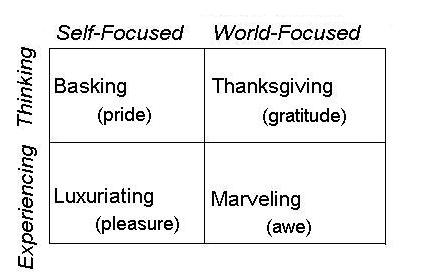This is an expression that my friend Margaret really likes to use, “We are human beings, not human doings.”
RECONCILING BEING AND DOING
But maybe sometimes we are human doings. There’s a wonderful brief blog entry by Jeanie Marshall about how people can act both in ways of achieving and reaching for their goals and in ways of allowing and taking in what’s around them without strain. Jeanie says, “At a very early age, most of us are taught to go after the things that we really want. We are often told that the willingness to fight is the indication that something is worthwhile. To fight, compete, and achieve are lifted up as important values. … If you have had such a cultural conditioning, it can come as a real shock to hear that what you need to do is “allow†or “be in the flow†or “relax.” These can seem like really soft or surreal ideas if you have proven yourself by doing things, by taking charge. … In my view, it is not such a paradox. Perhaps that is because I do not advocate replacing outward action with inward reflection; I am advocating a balance.”
To me, there’s something very soothing in the cadence of her words. Plus, what she says is a nice way to resolve the duality of the human beingness and the human doingness: you can have both. She continues, “Being, allowing, being in the flow, and opening are qualities that help you to remember and provide balance for doing whatever you do. Doers already know how to do; doers need to learn how to be, in order to recognize their wholeness. If every breath is only an out-breath, there is no in-breath to provide more air to sustain the next breaths.”
Martin Seligman, known as the father of Positive Psychology, says in his Authentic Happiness that one of the most powerful ways to increase happiness in the present is to savor more, to more fully enjoy the moments of life. Since so many lives are about action and activity, what are the ways that we can slow down and savor?
FOUR WAYS TO SAVOR
Fred Bryant has done research on savoring and writes that there are four different ways that people savor, that people enjoy the moment. And several of these may appeal to you greatly. (I learned about this theory of savoring from Karen Reivich, who heard Bryant present this four-types model in a talk). Everything in life is personal, including how you like to enjoy your downtime.
You can keep a brief log for the next two days to see when you are enjoying the moment, in which of these four ways are you really enjoying it? Are you …
* Basking: Receiving praise and congratulations
* Thanksgiving: Experiencing and expressing gratitude
* Marveling: Losing self in the wonder of the experience
* Luxuriating: Engaging one’s senses fully
Here’s a visual interpretation:

For example, enjoying the fresh salad during dinner is …
luxuriating,
looking at the sunset can be …
marveling or
luxuriating, or even
thanksgiving,
hearing someone compliment your cooking and saying “thank you” is …
basking,
seeing a little child smile at you can be …
thanksgiving.
Karen Reivich states that when you separate savoring out this way, you have a range of possibilities to choose from. It’s like deciding on a mild sage green for a paint color for the bedroom, as opposed to forest green or swamp green. You’re more in control of how you perceive savoring when you start to break savoring out into its components. And according to Diener and Myers, personal control is one of the four main components to happiness.
It’s like having a peacock’s tail of possibilities to choose from.
Sources:
Bryant, F. (1989). A Four-Factor Model of Perceived Control: Avoiding, Coping, Obtaining, and Savoring, Journal of Personality 57:4, 774-797.
Bryant, F. (2003). Savoring Beliefs Inventory (SBI): A scale for measuring beliefs about savoring, Journal of Mental Health, 12, 2, 175-196.
Myers, D. G., & Diener, E. (1995). Who is happy? Psychological Science, 6, 10-19. “In study after study, four inner traits mark happy people: self-esteem, a sense of personal control, optimism, and extraversion.”




